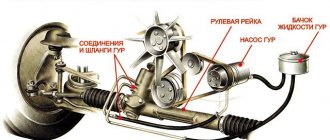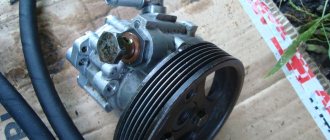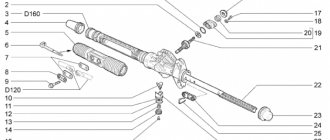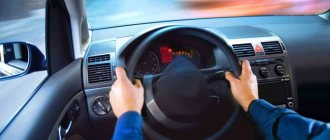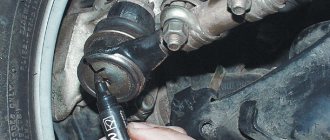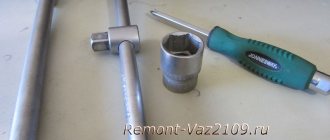Unfamiliar sounds made by the car when the steering wheel is turned (and this can be knocking, creaking, rumble, rattle, hum, etc.) do not yet mean the occurrence of a malfunction that must be eliminated. For example, cars with power steering sometimes make a very loud noise when turning the steering wheel (this is one of the specific features of some power steering). On the other hand, if instead of a hum you can clearly hear a squeak or, even more so, a knock, then it’s time not to rely on chance, but to stop by a car repair shop.
A very important thing when diagnosing a car will be whether you are able to clearly describe the nature of the sound during a turn - squealing, crunching, rumble, grinding, etc. Below we will look at the most common symptoms of such sounds and give you recommendations on how to eliminate the noise. However, you better be prepared in advance for the fact that the service master may ask you a number of things to which it would be better to answer - this will help him understand the problem. If possible, prepare answers to the following questions regarding steering noise:
- The type of sound produced (rumble/grind/crunch, etc.).
- Is the sound heard when turning the steering wheel, or under some other conditions?
- How do weather conditions, heating of steering system or suspension elements, weather, vehicle load, etc. affect the resulting sound?
- Does the car make noise when it spins in both directions or in one direction?
- Auxiliary signs or phenomena that occur with this noise.
If you are able to answer questions like these, identifying the problem and the cause of the noise will be much easier.
The front part of your car takes on a lot of different functions:
- prevents the car from leaning sideways when cornering;
- allows the wheelset to move up and down to dampen loads;
- control the direction of movement of the car using the steering wheel;
- transmits engine power to the wheels, giving the car acceleration (front-wheel drive).
As you can see, there are many factors that can influence the reduction in the service life of the elements of the front suspension and steering system. But not everything is so bad - many elements whose life is ending seem to warn the driver with strange sounds: “lubricate me,” “replace me,” “fix me.” True, such warnings almost always mean that the “screaming” part is already on the verge of wear or failure - therefore, it is highly recommended not to delay diagnostics. After all, some sounds sound like grinding, others like creaking, etc.
Below we will look at a number of typical sounds a car makes when the steering wheel is turned, as well as the factors that cause such noises. This is where the breakdown should be identified. Of course, this list is far from complete. In general, let's start the review, so read and remember well.
Rumble (steering wheel turns, car stops)
Typically, this sound is produced by the hydraulic booster, which is installed on many cars. And there is nothing scary about this noise. When you get into the car, you may feel this sound - now you know that it will appear regularly. It is extremely rare that such a sound is detected when the steering wheel is turned in only one direction.
It seems that you have become accustomed to this sound, the car has been used for a long time, but the hum becomes louder and more distinct - now it can be heard not only when turning the steering wheel in the absence of movement, but also while driving. Here, be sure to try diagnosing the power steering. The most common cause of such noise is a lack of special power steering fluid, so the problem is often solved when such fluid is added to the power steering reservoir located under the hood (it is marked with MIN and MAX marks, they mean the maximum and minimum amount of fluid). Obviously, at the MIN level, fluid is most likely leaking from the system, so after topping up, you will need to check this level for some time (at least once a week).
The noise may also be caused by a breakdown of the power steering pump, weak tension of the power steering belt, as well as air flow that has penetrated into the power steering circuit. Alas, in all these cases you should definitely contact a car repair shop.
As a rule, problems with power steering are almost always accompanied by the need to apply more force than usual to turn the steering wheel.
ATF fluid
There can be two problems with liquid: low level and low quality. In the first case, the check is reduced to a visual inspection. You need to open the hood and check the level of filling of the power steering reservoir. According to standards, the liquid should be above o. If lower, there is a leak in the system. As a rule, this happens at joints or on clamps. Systems with old, torn tubes are especially affected. Before topping up, you must urgently eliminate the cause of the leak!
As for the signs of inadequacy of the filled mineral water, the power steering begins to make noise in winter, since operation is not intended in such temperature conditions. The hydraulic booster also hums in cases of low ATF quality. If it contains a high content of impurities, the steering wheel will become increasingly difficult to turn. You can also diagnose dirty liquid visually: it will lose its original color and become crumpled. There is also a way to check: a few drops of oil are tested on white paper. Any color is acceptable except black, gray and brown. In addition, a normal liquid should not smell like burning. It is important to update the ATF within the period specified by the manufacturer - every 60-70 thousand km or 2 times a year.
Knock (steering wheel turns, car turns)
This kind of sound accompanies the car when turning. It is noteworthy that often a small turning angle and a bad road make the car make such a knock more strongly. The reason for this behavior of the car is the wear of the shock absorbers, which no longer dampen road irregularities. In this case, only replacing with new racks will help. As a rule, the axle struts have different degrees of wear, so it is likely that a knocking noise is heard only when the steering wheel is rotated in only one direction.
A knock can occur not only when turning, but also when moving straight along a poor quality road. The maximum load on the racks occurs when the steering wheel is turned, which is why the knocking sound is produced more often. Just in case, check the strut housings - they may contain oil smudges, which indicates an oil leak in the struts.
A car with a decent mileage (the word “decent” means different numbers depending on the model), the shock absorbers can fail (due to various factors). It would be useful to find out how susceptible your car is to this disease either in the official service center or in the appropriate forum dedicated to your car brand. You can also immediately go to a specialist to diagnose the racks.
Recommendations for extending the service life of power steering
In some cases, it is useful to add special additives to the power steering fluid. They relieve the force on the steering wheel, improve the operation of the unit as a whole, reduce vibrations and protect elements from wear. However, the components must be of very high quality, not fake, otherwise the mechanisms will begin to fail even faster, and the power steering pump will hum louder.
Particular attention is paid to the choice of ATF. First of all, the liquid must correspond to the temperature characteristics of a specific climate zone. Thus, mineral waters with the wrong viscosity will not cope with their functions in frosts below 15-20 ° C.
Knock (the steering wheel turns, but there is play)
Typically, the joints found in the steering system last as long as your car drives. However, under Russian operating conditions, faster wear is possible. Turning the steering wheel, accompanied by a faint knock at the beginning of rotation, indicates that the hinges are worn out (an increased gap has appeared). If you park the car on a level surface, then try to rotate the role from right to left, then from left to right (you need to start carefully with small movements), you can identify at what point in time the play and knocking sound appears. You can improve this method a little - open the car doors, then with the doors open, while outside the car, gradually turn the steering wheel from side to side. At some point in time, you will notice that the steering wheel rotates, but the wheels do not move - this means there is play. This backlash needs to be eliminated.
This can be done by diagnosing the hinges at a car repair shop (you need to check for wear and play), after which you need to replace the worn elements and tighten the necessary components that are causing the play.
Rules for proper use
If you do not want to face the problem of hum, then the first thing you need to do is to use your car correctly. First of all, keep in mind that on vehicles with power steering, you should not hold the steering wheel in one position for too long when turning or performing a maneuver. This is because during operation of the machine, the power steering device begins to heat up, the same applies to the working fluid, and if you keep the unit in one state, the liquid may even boil. Accordingly, the problem cannot be solved except by replacing the lubricant.
Experts also do not advise leaving your vehicle with its wheels turned for a long time, particularly during the winter cold. This can also lead to undesirable consequences for the steering system. If you notice that any malfunctions have begun to appear, it is advisable to diagnose the car as quickly as possible and fix the problem.
If there are serious faults, it is better not to even try to repair the unit yourself, especially if you are not confident in yourself. The best option would be to have your car repaired at a service station. Only by identifying malfunctions in the system in time can you ensure its long-term operation.
Grinding, as well as squeaking (the steering wheel turns both when driving and when standing still)
A grinding/creaking sound that is felt when the steering wheel is turned in different directions. This noise occurs due to wear on the suspension joints or steering joints. Similar to the previous point, here you will need to diagnose the suspension components or steering system, replacing worn parts, if necessary.
However, the most common reason for such a sound is the lack of lubrication in the steering tips (as well as their severe wear).
Thanks for subscribing!
Sometimes such a squeak can even be accompanied by a crunching sound, regardless of whether the car is moving or standing still. In this case, the culprits are the lower ball joints (sometimes the shock strut bearings). The first option is also accompanied by play in the steering wheel when the car is suspended.
Table: typical steering malfunctions, symptoms
| Signs | Malfunctions | Repair |
| Oil leak | Steering shaft oil seal wear or leakage is caused by torn boots, leaking cylinder tubes, leaking discharge or discharge tubes, simply worn steering rack seals | Rebuilding the rack, eliminating the cause and all weak points, perhaps the rack shaft |
| Heavy knocking | Wear of the right rack shaft bushing, play of the steering shaft in the bearing, violation of the contact angle of the rack and screw teeth, wear of the propeller bearings, vertical play of the propeller bearing, wear of the silent blocks securing the rack to the body, the rack has unscrewed from the body, wear of the central tooth of the rack shaft, steering rod hinges or cracker | Rebuilding the rack, eliminating the cause and all weak points |
| Strong backlash | Wear of the steering rod hinges or crayon, violation of the angle of contact of the rack and screw teeth, wear of the silent blocks securing the rack to the body, loosening in the steering column cardans of the steering column fork | Rebuilding the rack, eliminating the cause and all weak points |
| Knocking and play felt on the steering wheel when vigorously rocking it from side to side with the engine NOT running | The spool rests on its stops or excessive elasticity of the spool torsion bar | It is NOT a malfunction. Steering diagnostics are performed with the engine RUNNING. |
| Weighting of the steering wheel when rotating in some constant, repeating positions | Souring due to corrosion of the steering cardan | Cardan repair |
| Biting the steering wheel in one or both directions, especially when cold | Worn distributor housing or cylinder in the middle position | Rebuilding the rack, eliminating the cause and all weak points |
| Stiff steering wheel in some positions (extreme), and/or accompanying creaking. Poor steering self-return | The crayon stop adjustment is too tight, the rack or its housing is bent | Restoring the slats |
| The steering wheel turns tightly, and when you turn the steering wheel you can hear a whistle coming from under the hood. The steering becomes lighter as engine speed increases. The steering wheel “dances” in your hands when you try to turn it | Belt slippage on steering wheels with power steering | Replacing the pump drive belt or checking the operation of the tensioner. It is also recommended to check whether the crankshaft pulley on the rubber damper has rotated |
| The steering force is large at any engine speed and in both directions | Destruction of the rubber ring of the floating washer inside the pump. Found on low-quality pumps in power steering systems | Pump disassembly, ring replacement |
| An itching-like sound that intensifies when the steering wheel is rotated in place, appearing some time after the pump starts operating. Foam or air bubbles in the reservoir when the oil level is normal. In some cases, oil is squeezed out through the plug and/or the pump “sweats” from the pulley side | Air leakage through a worn pulley shaft seal | Replacing the oil seal or pump assembly |
| The steering wheel turns hard. There are no sounds from the pump. No reaction to gas | Damage to the pump shaft inside. Or rotor destruction | Pump replacement |
| The steering wheel turns tightly and you can hear a whine (itching) from the pump. The steering wheel may become lighter at high engine speeds. | Scuffing of the rotor and mating planes | Replacement of the pump, repair is impractical |
| An itching sound that gets worse when you turn the steering wheel in place. In the power steering reservoir you can see a gushing fountain, foam, liquid is thrown out of the reservoir. | Airing the power steering system | Replacing the power steering system reservoir |
If you have any questions, leave them in the comments below the article. We or our visitors will be happy to answer them
Crunching sound (steering wheel turns when driving; car with front-wheel drive)
It happens that when the direction of movement of the car changes, a strong crunching sound is heard. The greater the turning speed and the narrower the radius, the more pronounced it is. There is a feeling that the steering wheel does not play any role here, and that it is the turn itself that is to blame, that the crunch is heard in the area of the loaded wheel (remember that this is the wheel from the outer radius of the turning curve). Most often, this picture is characteristic of turning only in one direction.
Only all-wheel drive vehicles or vehicles with front-wheel drive suffer from such problems. The culprit for this is the constant velocity joint, which in our country is called the “grenade”.
This hinge is a prefabricated element that serves to rotate the front wheel along any axes at a certain angle, without losing the constant speed of the axle. When the car moves, the CV joint rotates all the time, experiencing heavy loads. From time to time, this part runs out of service prematurely, in which case it will need to be replaced.
Checking the “grenade” looks like this. The steering wheel must be turned to one side all the way. After this, you should start moving the car in a circle - in one direction, then in the other. The crunching noise heard during such an operation means that the CV joint is the culprit. If there is vibration that may accompany such a crunching noise, the car must be taken to a professional mechanic without delay.
The so-called boot protects the CV joint from dirt and dust. Often, wear of the “grenade” occurs due to damage to the boot. Actually, the sound of a crunch means that either particles of sand or dirt have penetrated through the boot into the CV joint and the joint begins to grind it all, or the crunch is caused by the collapse of the bearings inside the CV joint.
The machine is not the simplest mechanism. Its steering system and suspension include a huge mass of elements. The suspension and steering differ in their functionality, design, and elements (and differences may appear from model to model; differences may even exist in modifications). For this reason, various noises do not need to be produced only for the reasons described above. For example, noise can be caused by the steering rack, steering column, steering knuckles, struts and joints. An old, falling-off element, which is not directly related to either the suspension or steering, can touch parts of the above systems during a turning maneuver or on road irregularities, causing noise.
In any case, the main thing you need to do when you hear an extraneous sound accompanying the turning of the steering wheel is to determine the other signs accompanying the noise (the car is pulling to the side, a more specific definition of noise). After this, it is necessary to check each boot of the suspension and steering systems, inspect the steering wheel, and check for play.
Reading time: 4 minutes
The driver of a car, turning the steering wheel, sometimes hears extraneous sounds coming from the front of the car. Sometimes they don’t mean anything, but in some cases, when you hear a grinding sound in the wheel area when turning the steering wheel, we are talking about serious problems.
When turning the steering wheel, a grinding noise is heard in the wheel area
What could be the reason
When you hear squeaks, grinding noises, or crunching noises from a wheel when turning, this may be due to one of the following reasons:
- Due to long-term use, the steering rack wears out. It is possible that the noise is due to the fact that the fastening is loose.
- This result is caused by a faulty steering column.
- If the shock strut bearings need replacing or have bad ball joints, this is also a possible cause of the noise.
- The drive mechanism must operate in clean conditions, but if the anthers rupture, dirt will get inside and disrupt its operation.
Tips for good power steering performance
By following simple rules, it is very easy to increase the service life of the hydraulic steering system.
- Timely check of the hydraulic fluid level;
- Oil change exactly on schedule;
- Fix the wheels in a level position;
- If there is a problem with the hydraulic system, correct the problem immediately;
- Periodically inspect the steering rack for damage and malfunctions;
- Choose high-quality power steering fluid.
Do not make sharp turns with the wheels turned out, or fix this position for no more than 5 seconds.
By strictly following all the rules for the safe operation of a hydraulic installation, you can maintain its functionality for a long time and save a lot on expensive repairs.
What to do if you hear a grinding noise near the wheels on a VAZ-2114 when you turn the steering wheel
A similar grinding noise can be heard when there is a fault in the support bearings of the steering column.
It happens that the source of noise is in the wheels. In this case, there may be various reasons for the problem. Here are the most likely ones:
- Due to the rubber being torn, stones or crushed stones got into the outboard bearing of the cardan.
- This sound may occur due to friction of the brake pads against the discs.
- A loose retaining ring can be another possible cause of grinding noise.
- In cold weather, noise may occur if there is insufficient lubrication. If you add it additionally, the problem will disappear.
Not only the above reasons are possible here, but also other reasons.
Adviсe
If the sound you hear from the front of the car resembles a gurgling noise, the most likely cause is high wear on the tie rod ends. In this situation, it is not recommended to continue driving. Otherwise, there is a possibility that the steering control system will be damaged in this way.
Both of these tips are changed at the same time, and this entails significant financial expenses. After the repair, it will be necessary to adjust the wheel alignment.
Sometimes when driving there is a muffled knocking sound. In this case, it can be argued that the bearing is worn out and needs to be replaced.
Tie Rod Ends
Recommendations
When you hear a grinding sound from the front wheels, you need to try to more accurately determine the nature of the sound. One possible source could be a damaged plastic fender liner. Although the grinding noise may be loud, it is not dangerous and can be easily fixed.
You need to pay attention to exactly when the noise appears. If it started after the car overcame the hole, then it may be a problem with the shock absorber spring. It is recommended to replace this part. If the spring is welded together, it will not be as strong as before.
A clear creaking sound when turning the steering wheel - checking for possible problems
Before doing this, you need to clarify what is happening. To do this, you need to answer the following questions:
- It is necessary to more specifically determine what kind of noise is heard. To be clear, this refers to a squeaking, grinding, knocking or other sound.
- It is necessary to clarify the circumstances under which this occurs. Some possible answers to this question: while moving, while stopping, or in another case.
- How constantly does the noise occur and when: with any movement or only in some specific circumstances.
- It is necessary to find out whether the creaking occurs in the same way when turning in both directions or only occurs in one direction.
Various features of why the wheels squeak when turning and the malfunction that has occurred will enable car service specialists to repair the car.
Shock absorber spring burst
When you hear a creaking or crunching sound in the wheel area, it is necessary to determine its source and carry out repairs. In some cases, if you do not pay attention to the problem that has arisen, it will cause serious damage.
Crunching sounds when turning the steering wheel are not a common malfunction, so they can confuse car owners - many simply do not have experience in dealing with this scourge due to its rarity. Meanwhile, the phenomenon is very insidious. It is very dangerous to let the situation with the steering take its course, so when the first oddities (including sound ones) appear in its operation, you need to react. The problem is that the crunching has one obvious reason and many unobvious ones. It’s good if the problem can be fixed in an obvious way, because otherwise the cause of the squeak can take a long time to find.
Crunching noise when turning the steering wheel while driving
A striking feature of the “steering” crunch is whether it is heard only while driving or is heard while standing still. This classification allows you to choose the desired search direction. If a crunching sound is heard during turns and maneuvers in motion, then with a high degree of probability the problem is in the CV joint. Constant velocity joints allow you to shift the plane of torque transmission. Usually in a front-wheel drive car there are two pairs of them - the internal ones are located near the exit from the gearbox, and the external ones are located directly near the wheel and allow torque to be transmitted even when the wheels are turned out. It is when the steering wheel is turned at speed that a sharp sound appears, the frequency depending on the rotation of the wheels. It is difficult to confuse it with something else; drivers whose CV joints have started to creak at least once can easily recognize the breakdown the second time.
In general, the CV joint is a fairly simple and reliable design. Very rarely they die from natural wear and tear, and if this happens, it happens over very long runs, at least several hundred thousand kilometers. However, CV joints can fail at any mileage, even very little, the cause will be problems with the anthers.
A kind of rubber covers, designed to protect CV joints from dirt and water, either break due to contact with sharp stones, nails, wire and other debris scattered on the road, or fly off the mount. How long does a protected hinge last and how little does a hinge that gets dirt and water get into? Usually, it takes a little time from damage to the anther to a crunch. In theory, if you notice damage to the boot, but the CV joint has not yet crackled, then you can wash the assembly, lubricate it and cover it with a new boot, but rarely does anyone inspect the car at least weekly from a pit or a lift, so damage to the boot usually becomes obvious after The CV joint crunched. In the vast majority of cases, problems arise with external CV joints.
It's buzzing when it's hot
There are several reasons why the hydraulic steering system hums when the engine is hot:
- the pump is completely damaged, especially if a symptom such as steering wheel vibration is added;
- the pump mechanisms are worn out, for example, the bearing, especially if the knock is noticeable at the bottom;
- the wrong fluid is filled in or it has used up its resource - the viscosity of the ATF is lost, the pump does not create the required pressure;
- problems with the steering rack - explained by the fact that at high temperatures the viscosity of the oil decreases, it escapes through damaged oil seals.

